|
THIS MONTH I'VE MOSTLY BEEN PLAYING
Date: November 2008
Game: Trackmania (DS)
Reason: because dammit,
there has to be
a good DS racing game out there somewhere.
Racing
games are the DSí Achilles heel. Since an excellent but unadorned
port of Ridge Racer 64 four years ago and a decent enough iteration
of Mario Kart a year later, the system has been noticeably lacking
in whatís arguably modern gamingís most popular genre. Yet thereís
no inherent reason for it Ė RRDS shows that the machine is capable
of moving big, detailed scenery around at breathtaking pace (by the
later stages itís terrifyingly fast) and can fit lots of
tracks onto even a small cart (at just 32MB, Ridge DS is only
one-eighth of the size of the DSí biggest ROMs), and digital
controls didnít stop games like the original Ridge Racer, Daytona
USA and Sega Rally being massive hits in the PS/Saturn era. So where
are the great post-2005 DS racers? And surely there must have been
at least ONE good one in the whole of 2008, the DSís biggest year to
date?
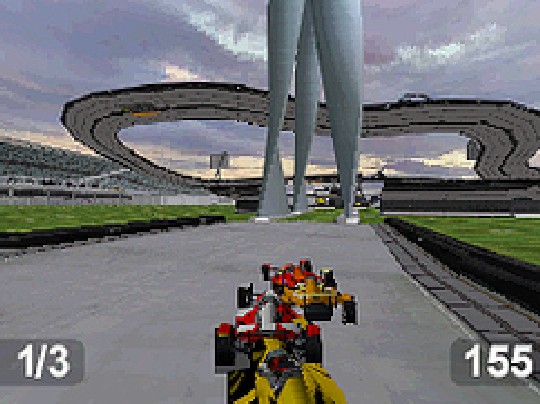
Good luck figuring out where to go next.
Trackmania DS certainly isnít it. Since your reporterís valued
friend and colleague J Walker
of Rock, Paper, Shotgun
came back breathless with excitement in the summer after visiting
developers Firebrand for a preview, itís looked as if the handheld
version of the hugely popular PC series might be the game to finally
wave the (chequered) flag for the DS in the world of racing. And
when it finally appeared this month, first impressions were pretty
encouraging Ė TMDS has a splendid engine that carries the high-speed
action along more smoothly than a greased hovercraft on a Teflon
ice-rink, even during the incredibly fleeting moments when there are
more than two cars on the screen at once. (Possibly because it isnít
wasting any CPU time on bothersome collision detection Ė TMDS is a
time-trial game, and your ďopponentsĒ are ghosts who exist only to
provide a visual cue for how close you are to the target pace. In
fact they just get in the way visually, and thereís no point in ever
choosing to have more than the one whose medal time youíre trying to
achieve displayed. Oddly, you canít race against a ghost of your own
previous lap time.)
But
like the same developerís DS version of GRID from a couple of months
before (see below), Trackmania is a case of a great engine wrapped around some
really poor game design. Despite being capable of pretty stunning
draw distances, it spends most of its time lazily cheating you with
blind corners and jumps, giving you no possible way of working out
where youíre supposed to be going until itís too late. The gameplay,
then, chiefly consists of speeding down the track until you fall
foul of some hidden obstacle or pitfall, then immediately
restarting, remembering where it was, and repeating the process
until youíve trial-and-errored your way to the end. (Itís no
accident that thereís a one-touch ďinstant restartĒ button, because
otherwise thereíd be a nationwide epidemic of smashed DSes.) For
those of you old enough to understand the reference, itís Rick
Dangerous Racing.
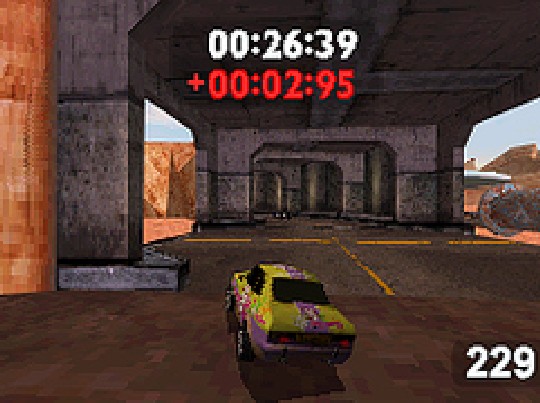
You rarely see Trackmania screenshots like
this.
Because itís so fast and slick and jaunty, TMDS is one of those
games that you try really hard to like, despite the way it regularly
spits in your face. In the brief period between learning where a
trackís hidden traps are and executing a successful gold-medal run
through them, itís even possible to forget how much the designers
hate you and actually enjoy yourself for a few minutes. But then it
just throws up another particularly loathsome course like Desert C2,
or it starts putting great big hidden holes right in the middle of
the track on the Stadium ďDĒ levels. (These are a standard feature
of the dismayingly awful ďPlatformĒ stages, where they should have
had the decency to stay Ė I mean seriously, what sort of PRICK
builds a high-speed racetrack with enormous fucking HOLES in the
road?)
Or you
just run into a brick wall in the tiresome unlocking structure and
canít get any more tracks to play on, or you suffer some
particularly blatant piece of AI cheating where youíve been going
flat-out for 10 seconds without a single error and the CPU car just
zips past you and disappears into the distance anyway, or something
else equally cheap and sneery happens, and eventually Trackmania DS
passes your own personal putting-up-with-shit threshold and gets
frisbeed out of the window forever. (For most people, I estimate
this will be somewhere around the end of the ďCĒ levels/beginning of
the ďDĒ levels, where the balance between enjoyment and frustrating,
unfair repetition really starts to go off the scale.)
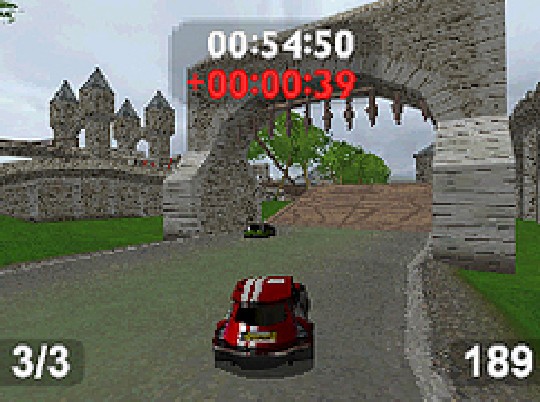
The handling of the Minis is fairly
ridiculous. They practically move in right angles.
The tin lid is the absence of any
sort of online mode or even leaderboards (the online functions being
what made Trackmania popular in the first place, of course), making
the construction kit which occupies space that could have been used
for more tracks a near-total waste of time. (And the game could
certainly have done with more tracks, because youíll gold-medal the
75 built-in ones in three or four hours if you can stand the
ever-increasing levels of cheating for that long, and quicker than
that if youíre a TM veteran.) In a particularly cretinous piece of
metastructuring, you even have to spend in-game money on buying the
building blocks for the editor, when youíll want to use it to unlock
the tracks.
Trackmania DS is a sort of low-budget Fisher Price version of the
PSPís splendid Gripshift (also available on XBLA and PSN, and warmly
recommended on all formats). If you want to be reminded of just how
inferior the DS catalogue is in the racing field, itís the game for
you.
-------------------------------------------------------------------------------------------

The sort of tracks GRID likes to pretend to be
full of.
RACE DRIVER: GRID (Codemasters)
Firebrandís other big release isnít the one to save the day either,
which is a crying shame. It starts fantastically, with an all-action
race through the streets of Milan, eight cars all jockeying for
position in the narrow street circuit with lots of 90-degree turns
and fast straights. Unquestionably the DSís most impressive-looking
racer, with big vehicles and lots of detail making it look like a
miniature Project Gotham, GRID then immediately throws it all away
as it descends into an utterly miserable Gran Turismo wannabe with
time trials, braking tests, drift exercises and possibly the most
catastrophically misjudged single inclusion of any racing game ever
Ė an ďeventĒ where instead of driving round a road really fast you have to design an entire three-mile-long
track with the clunky course editor.
No, I'm not kidding. 10 minutes into the high-octane racing action
for which you presumably bought the game, you have to stop, learn
how to use a fiddly, annoying construction kit, grasp some
principles of racetrack design, and laboriously build a pretty
lengthy track with it (I'd just about let them off if you could
knock out a quick oval loop) before the game will let you progress.
Do you think anyone ever made
Lewis Hamilton do that before theyíd let him get in his car and have
a race? Iím not sure anyoneís ever put anything more epically
retarded in a videogame in all of human history, and Iím including Otis from Dead Rising in that
calculation.

What you'll actually be looking at most of the
time.
After
the brilliant Milan opener, just three of the next 18 events involve
you actually racing against other cars, and one of those puts you
behind the wheel of a hideous American monstrosity that steers like
an oil tanker falling down a mountain, which you have to navigate
around 150-degree corners in the angular streets of San Francisco.
Luckily, said streets are so narrow and your beast of a car so wide
that thereís little chance of anyone overtaking you no matter how
many dozens of times you smash into the walls, and the damage
allowance is so generous that you can afford to, so the race is as
easy as it is unenjoyable.
If you know what happens after the 19th
event, youíre a far stronger and more persistent person than I am,
though probably also a considerably stupider one with much lower
standards. If Firebrand ever hire anyone who knows half as much
about actual game design as they evidently already do about how to
program the DS, they're going to come up with one hell of a racing
game. This definitely isn't it, though. Could someone explain to me
what it was it that ever gave some idiot designer the moronic idea
that the reason people want to pretend to get behind the wheel of
insane 300mph supercars is so they can DRIVE THEM AROUND SOME
FUCKING TRAFFIC CONES? Thanks in advance.
-------------------------------------------------------------------------------------------
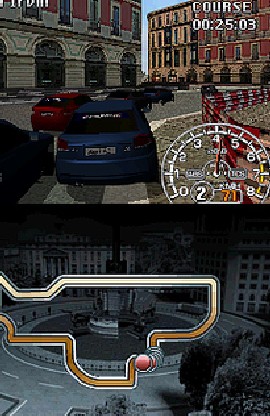
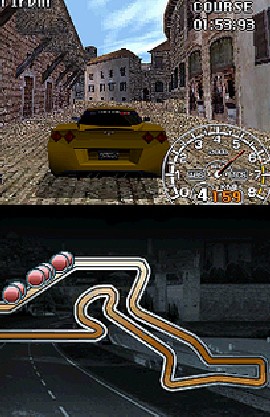
Lego Car Racing DS can't be far away now, and
it'll surely look like this.
EVOLUTION GT (Black Bean)
Compared to GRID, Evolution GT looks like it was drawn by one of
Firebrandís developersí learning-impaired child with a chisel and a
bucket of gritty dog vomit, but God bless it, it actually lets you
race against cars! It also offers eight nicely-designed tracks
spread across various European locations, from the winding country roads of
the Scottish Highlands to the tight city streets of Barcelona, but
thatís about it for good news. The AI was apparently coded by the
graphics artistís less talented younger brother, and features a
collection of drivers with a single hive mind who are accordingly
prone to lining up duckling-fashion behind each other in a single
file that only gets messed up if you disturb their formation, at
which point they all fight to get back onto the same position on the
track at once, causing endless comedy mayhem.
The
upshot of all this is that unless you get caught up in the middle of
said chaos, itís a piece of cake to get past all the CPU drivers in
one go, and then stay in front of them simply by holding the racing
line (in the unlikely event they ever catch you up anyway), which
will cause them to dumbly ram straight into your rear bumper over
and over again even if youíre going at 20mph.
Weirdly, the game is full of unlockable licenced cars that you donít
get to actually drive in the main Career mode (your vehicle is
always chosen for you, with the unlockables only available in Quick
Race and Time Trial modes), which removes any last glimmer of
interest, since the CPU AI offers no obstacle to your progress at
all, even at the highest of the four difficulty levels when the
enemy cars at least go a bit faster. And you have to unlock the
levels in turn anyway, which means literally hours of unbearably
tedious processions through the tracks on the easier levels until
youíre so heartily sick of them that the prospect of Pro levelís
Berlin race going on for four long laps makes a grisly, drawn-out suicide by combine
harvester seem an attractive alternative.
------------------------------------------------------------------------------------------
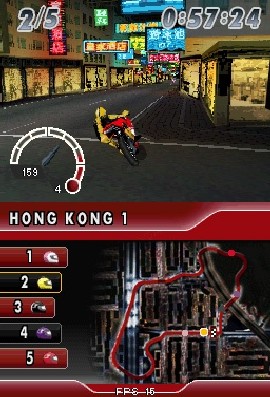
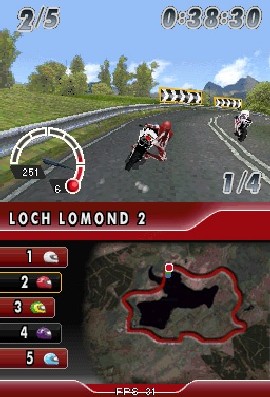
That glimpse of Hong Kong is the only one 99.9%
of Ducati Moto players will ever get.
DUCATI MOTO (ZeniMax)
The DS is rather
better served with motorbike racers than most other consoles, which
is to say it has more than one (the soul-crushingly funless Moto GP
being pretty much the only option on the big machines). Itís still a
genre on the margins, though, and as a result it still tends to
mostly see releases by people who are a bit mentally subnormal.
Ducati Moto is a perfect example Ė a game with a splendid fast
engine, great handling, a large number (15) of excellently-designed
tracks in interesting and varied locations, very accomplished
graphics, and a game structure for which someone needs to have
strong-smelling fish nailed to every part of their body and then be
lowered by their feet into a large
pit full of starving polar bears until thereís nothing left but
blood-stained toenails.
When you first play Ducati Moto you
think youíve uncovered an obscure treasure and wonder how such a
good-looking and exciting game could possibly have been missed. Then,
slightly baffled, you wonder why youíre being asked to race the same
track that you just won on again. And again. And again. And again.
And again. And again. Because Ducati Moto is so incredibly, spitefully
mean-spirited that it simply wonít let you off a track until youíve
accumulated dozens of Championship points on it, for which it forces
you to perform endless repetitions of PGR-style tasks: normal races,
but also token collections, time trials and Ė most heinously of all
Ė three different types of absolutely awful ďStunt ChallengesĒ.
You canít even mix and match these
tasks to stave off the boredom of repetition Ė youíre not allowed to
attempt a single Stunt Challenge until youíve come first in Race,
Time Attack, Eliminator and Race Line modes, all on the same track.
Since doing that is likely to involve a good 20 or so attempts even
on the easy starting tracks (Ducati Moto has some pretty decent
opposition riders, and it takes a LONG time to accumulate enough
money from beating them to upgrade your bike into something
competitive), itís hard to overstate how much youíll come to hate
the sight of each one before the game reluctantly deigns to unlock
another course from its well-stocked but jealously-guarded
cupboards.
Itís
clear that for some reason, the designer of Ducati Moto absolutely
LOATHES the people who are going to play it, which is a terrible
shame because everyone else who worked on it did a fantastic job
that nobodyís ever going to see. No other explanation is possible,
because words seriously canít do justice to just how staggeringly,
insanely,
OBVIOUSLY terrible the structure of this otherwise-superb game is.
Pity.
------------------------------------------------------------------------------------------
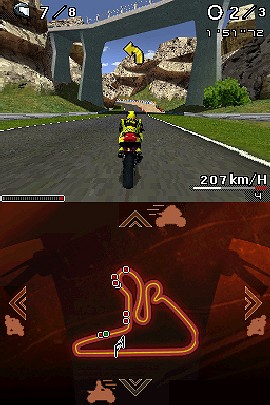
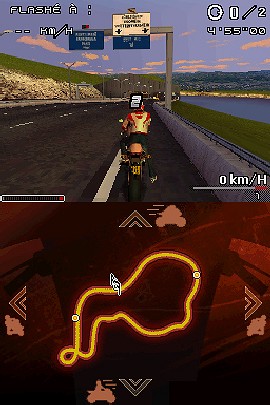
Moto Racer DS is full of lush, blue-sky scenery.
MOTO RACER DS (Electronic Arts)
The other DS bike racer of
2008 at least initially holds more promise, because it comes with a
top-quality pedigree. The first two Moto Racer games on the
Playstation 1 were simply magnificent pieces of work, right up with
Suzuki Alstare Extreme on Dreamcast in the ranks of the finest
motorbike games ever made. Since then, though, EA have undergone
something of a policy shift towards making all their games easy
enough for seven-year-olds to finish in a week, and Moto Racer DS
sadly didnít escape the clutches of their dreaded Infantilisers.
Itís not all bad news, though. Once
again, the technicians have done a great job in exposing the myth
that the DS canít do decent 3D. This is a good-looking, fast-moving
game with ultra-responsive controls and a rock-solid framerate even
when youíre turbo-boosting past a full pack of CPU riders. You get
dozens of tracks, with the traditional Moto Racer spread of road
races and dirt-track motocross meets alongside a category I donít
recall seeing before Ė Traffic, which offers head-to-head races or
Mission events, both set on city tracks not seen elsewhere in the
game. In the latter you have to perform tasks like riding the wrong
way down a busy city street for a certain amount of time, or
complete a race by overtaking red cars on the left and blue cars on
the right in a highly inventive take on the slalom.
The sheer amount of content packed
into MRDS is pretty impressive, and unlike Ducati Moto youíre
actually allowed to access a lot of it from the beginning rather
than having to do 100 laps of the same track before you get a
glimpse of another one. But irritatingly for those of us over seven,
the harder difficulty settings are one of the things that are
quite obstinately locked, and you better be ready to wade through a good
couple of hours of varied but insultingly easy events before youíll
be allowed to encounter something vaguely demanding. (By which time,
of course, thereís no novelty left and little motivation to carry on, because youíve already seen all
the courses in Compulsory Baby Mode.)
The
motocross events (subdivided into race and stunt modes) are much
less accomplished than the road racing, but unlike Ducati Moto you
arenít forced to play the horrible bits in MRDS, and the two good
modes easily add up to a respectable whole game by themselves. Itís
just annoying and stupid that EA not only feel the need to dumb down
their arcade games for cack-handed children whoíll probably be
buying Spongebob Squarepants Kart Racing instead anyway, but much
more idiotically to lock the adult difficulty settings away from
people whoíve paid good money to get an enjoyable motorcycle racer
without trudging through hours of kiddy preliminaries first.
------------------------------------------------------------------------------------------
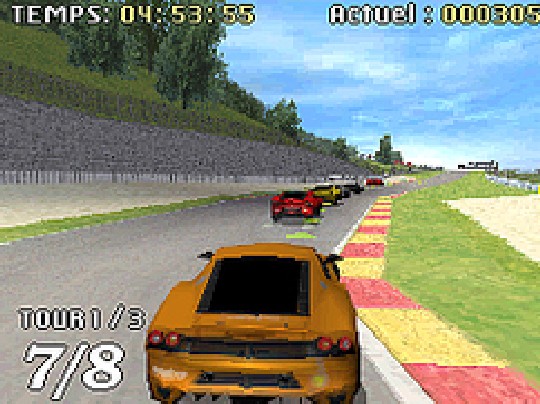
Man, DS screenshots really don't come out well
from being blown up, do they?
FERRARI CHALLENGE (System 3)
I canít really explain why I
donít hate this. Itís a little-heralded sterile track racer in the
vein of Gran Turismo and (more obviously) Segaís arcade nerdfest
Ferrari F355. Itís yet another Firebrand effort, thatís been coded by
most of the same people as Evolution GT and has single-file CPU AI thatís almost
as dim. While the graphics are a lot less gritty-looking this time
round, with much more crisply-defined cars, thereís a visual tradeoff
for it in that all eight of the courses are
near-identical featureless
flat grey GP circuits. Itís also a Ferrari licence, which means itís
aimed at the most wearying and joyless sort of petrolhead
trainspotter. And yet thereís something modestly, unassumingly
likeable about it.
It could simply be that it starts to
offer some resistance earlier than almost any game in this roundup,
with the opposition actually putting up a fight anywhere after the
Easy races. (Itís got the same irritating unlocking structure as its
sibling and Moto Racer DS, though, so you canít just jump straight
into Medium and start enjoying yourself without enduring a bunch of
training-wheels races.) In fact, Iím pretty sure it IS that, so I
wonít bother going through a long and boring list of other possible
reasons.
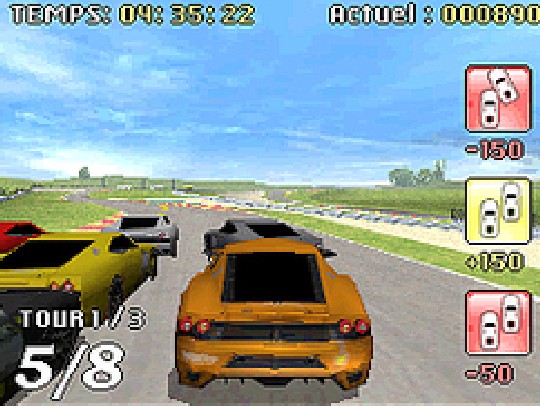
It all looks clean and sharp onscreen, though,
so don't fret.
This
is about as stripped-down a DS racing game as you could get, with
the exception of the curious little Top Trumps minigame that hides
away on the main menu under the innocuous title ďChallenge CardsĒ.
(PRO TIP: In the ďageĒ category, older is better.) But simply
by showing the player a little modicum of respect and NOT assuming
that he or she is a ham-fisted sugar-rushing toddler in a blindfold,
it overcomes the handicap of its DNA and turns into something thatís
quietly engrossing.
And it even manages to do it without the sort of
endless obsessive hubcap-tweaking or rollerskating-hippo handling that so
often ruins games in the nerd-racer genre. (Ferrari Challenge has a
simple driving model where the cars feel nice and heavy and take
skill to get round the track at speed, but don't slew wildly all
over the place when you're just trying to go in a straight line like
so many "serious" racers feel obliged to do for some reason. I don't
know where those guys buy their cars, but I'd get down to a mechanic
pronto if I was them, or at least to Kwik-Fit to see if all the
tyres are bald. Real cars, even highly-tuned racing ones, just don't
handle like that, you dolts, or there'd be 500 racing drivers killed
every year.) Whodathunkit? Itís
practically the best DS racing game of 2008.
------------------------------------------------------------------------------------------
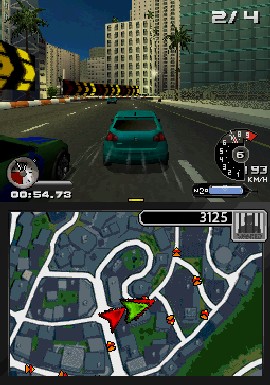
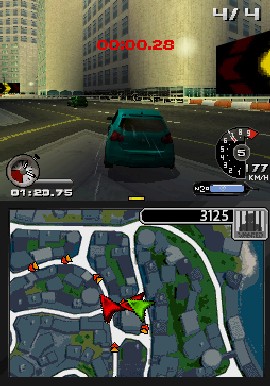
The map screen deserves special credit - it's
so accurately done you can steer by the
map alone most of the time, without even needing to look at the main
screen.
NEED FOR SPEED: UNDERCOVER (Electronic
Arts)
But
almost as unexpectedly, thatís actually this one. EAís
flogged-to-a-whimpering-pulp Need For Speed franchise hasnít seen a
decent game (unless your favourite TV show is Pimp My Ride, anyway)
since about 1995, and as it wasnít launched until 1997 thatís
quite a poor record. The four previous DS titles in the series were
all epoch-shatteringly, questions-asked-in-Parliament terrible, and
there wasnít any reason to expect anything else from this one when
it showed up in mid-November (WARNING! WARNING!), just in time for
the Christmas market.
But this
time round, EA finally wised up to the fact that nobody likes seeing
gigantic blocky graphics lurch around the DS screen at three frames
a second, drew the camera back and reduced the scale a bit, and
produced a fast-moving game that in fact pretty much resembles Grand
Theft Auto without the walking-around bits.
NFS
Undercover even features, rather startlingly, a mildly interesting
plot, which is moved on at regular intervals with mercifully-short
stills cutscenes used to concisely explain a story in which you play
both criminal and cop. After each cutscene the game unlocks a
handful of challenges in which you might have to complete a circuit
or eliminator race, overtake a rival, cause a certain amount of
damage to vehicles and scenery, evade roadblocks and pursuing lawmen
to get a stolen car to a safe house in one piece without having the
fuzz on your tail (those are my favourites), or
chase, ram and catch your former criminal associates and deliver
them to the police station.
The
action takes place in a large city and its surrounding region, and
there's a well-judged balance between giving you time to get
familiar with an area and moving you off somewhere else to provide a
change of scenery before you get bored (and cleverly gradually
overlapping areas as your patch gets bigger, so that you return to
places you know from earlier). The structure is flexible in allowing
you to play unlocked stages in any order and move on without beating
every last challenge in a section, and there are all the
car-upgrading-and-pimping shenanigans you'd expect from a Need For
Speed title, but nothing you need to spend any time on if you don't
want to - you'll gather plenty of money, without really noticing, to
simply buy faster cars if you're struggling to beat events with the
ones already in your garage.
It's not
perfect. Enemy AI is unsophisticated, and the EA Infantilisers have
ensured that you'll be 40 or 50 missions in (out of a total of
80-ish) before you start regularly encountering ones that'll hold up
your progress significantly (those that do before then are mostly
the rare and comically absurd Highway Battles, where your opponent
seems to be able to ghost through other cars while you crash just
from getting within four feet of them, and then suddenly boosts away
from you at twice the speed of sound). It's possible that you'll
have wearied of all the event types by the time it gets anything
approaching properly difficult. But NFSU tries its little socks off
to stop that from happening by throwing different scenery, really
interesting course design and little plot twists at you (along with a
Most Wanted high-score table that you move up at just the right
speed), and it more or less pulls it off.
It's got
more sense of coherent place than any DS game not aimed at
nine-year-old girls, a fair amount of genuine invention, and a sheer
volume of content that'll make sure you get plenty of entertainment
value for your money even if you don't make it all the way to the
end. It blends GTA with Outrun 2, Crazy Cars 3 and Chase HQ, and if
that sounds like a good idea to you then the execution isn't going
to disappoint you. If you want a more pure and traditional racing
experience, stick to Ferrari Challenge. But as a jack of all trades
and master of some of them, NFSU is the best DS racing game of the
year.
The Trackmania section of this piece originally
appeared on Snappy Gamer.
|

